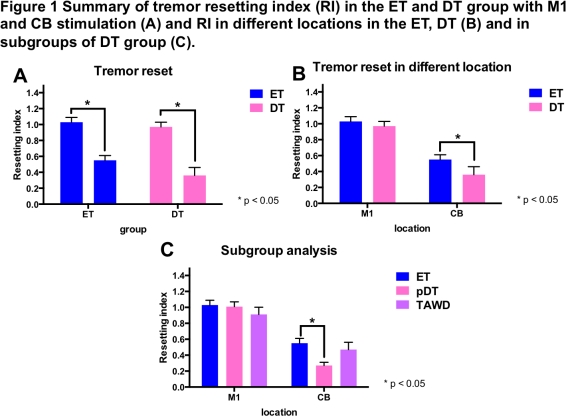Session Information
Date: Tuesday, June 21, 2016
Session Title: Tremor
Session Time: 12:30pm-2:00pm
Location: Exhibit Hall located in Hall B, Level 2
Objective: To explore the role of M1 and CB in the pathophysiology of ET and DT by assessing tremor resetting with motor cortex (M1) and cerebellar (CB) stimulation and cerebellar brain inhibition (CBI).
Background: The mechanism of tremor in essential tremor (ET) and dystonic tremor (DT) is still unclear. The cerebellothalamocortical (CTC) pathway has been suggested to be involved in tremor genesis in ET but unknown in DT.
Methods: 12 ET and 11 DT patients were studied. Patients with DT were subdivided into 7 patients with pure DT (pDT; tremor and dystonia in the same limb) and 4 patients with tremor associated with dystonia (TAWD; isolated tremor with dystonia elsewhere). Tremor resetting was tested by applying single pulse stimulation over the contralateral M1 or the ipsilateral cerebellar cortex to the more affected side of tremor in both groups. TMS effect was evaluated by calculating the tremor-resetting index (RI) from the EMG bursts of forearm muscles. CBI was obtained by cerebellar stimulation followed by M1 stimulation at the interstimulus interval of 5 ms. Tremor RI with M1 or CB stimulation was compared between ET and DT and between ET and DT subgroup. CBI was also compared between patients groups and healthy controls.
Results: M1 stimulation induced higher RI than CB stimulation in both ET and DT (p < 0.01). There was no significant difference in RI with M1 stimulation between groups. CB stimulation resulted significant and higher RI in ET than DT (p = 0.02). Subgroup analysis comparing between ET, pDT and TAWD patients showed that RI was lower in pDT but not TAWD compared to ET (p = 0.01).  CBI was not significantly different between ET, DT and controls. However, subgroup analysis showed significant higher CBI at rest in pDT but not TAWD and ET comparing to healthy controls (p=0.04)
CBI was not significantly different between ET, DT and controls. However, subgroup analysis showed significant higher CBI at rest in pDT but not TAWD and ET comparing to healthy controls (p=0.04) 
Conclusions: Our study suggests that M1 stimulation resets tremor similarly in both ET and DT while CB stimulation resets tremor in ET more than DT. This would indicate that tremor in ET and DT might be mediated through different oscillatory pathways. M1 might be involved in all types of tremor as the main output of tremor generator whereas CB or CTC pathway might be more involved in ET. Tremor genesis in TAWD is likely more similar to ET than pDT.
To cite this abstract in AMA style:
P. Panyakaew, H.J. Cho, P. Srivanitchapoom, M. Hallett. Resetting tremor by single pulse transcranial magnetic stimulation at the motor cortex and the cerebellum in essential tremor and dystonic tremor [abstract]. Mov Disord. 2016; 31 (suppl 2). https://www.mdsabstracts.org/abstract/resetting-tremor-by-single-pulse-transcranial-magnetic-stimulation-at-the-motor-cortex-and-the-cerebellum-in-essential-tremor-and-dystonic-tremor/. Accessed December 20, 2025.« Back to 2016 International Congress
MDS Abstracts - https://www.mdsabstracts.org/abstract/resetting-tremor-by-single-pulse-transcranial-magnetic-stimulation-at-the-motor-cortex-and-the-cerebellum-in-essential-tremor-and-dystonic-tremor/
